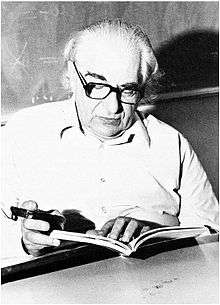Mário Schenberg
Mário Schenberg (var. Mário Schönberg, Mario Schonberg, Mário Schoenberg; July 2, 1914 – November 10, 1990) was a Brazilian electrical engineer, physicist, art critic and writer.
Mário Schenberg | |
|---|---|
 | |
| Born | Mayer Schönberg July 2, 1914 |
| Died | November 10, 1990 (aged 76) São Paulo, Brazil |
| Alma mater | University of São Paulo |
| Known for | Schönberg-Chandrasekhar limit Urca process |
| Scientific career | |
| Fields | Theoretical physics |
| Doctoral students | José Leite Lopes |
| Notes | |
One of the most important Brazilian physicists of the 'heroic era' (1900–1945), together with José Leite Lopes, Cesar Lattes, Jayme Tiomno, and Joaquim da Costa Ribeiro. | |
Early life
Schenberg was born in Recife, Brazil. His parents were Russian-Jewish of German origin. From early on he showed remarkable ability for mathematics, enchanting himself with geometry, which had a strong influence on his works. Schenberg took the primary and secondary courses in Recife. Because of his family's financial limitations, he was not able to study in Europe. He then entered the Faculty of Engineering of Recife in 1931.
Scientific work
The Urca process
Widely regarded as one of Brazil's most important theoretical physicists, Schenberg is best remembered for his contributions to astrophysics, particularly the theory of nuclear processes in the formation of supernova stars. He provided the inspiration for the name of the so-called Urca process, a cycle of nuclear reactions in which a nucleus loses energy by absorbing an electron and then re-emitting a beta particle plus a neutrino-antineutrino pair, leading to the loss of internal supporting pressure and consequent collapse and explosion in the form of a supernova. George Gamow (1904–1968) was inspired to name the process Urca after the name of a casino in Rio de Janeiro, when Schenberg remarked to him that "the energy disappears in the nucleus of the supernova as quickly as the money disappeared at that roulette table".
Schönberg–Chandrasekhar limit
Together with Indian physicist Subrahmanyan Chandrasekhar (1910–1995), he discovered and published in 1942 the so-called Schönberg–Chandrasekhar limit, which is the maximum mass of the core of a star that can support the overlying layers against gravitational collapse, once the core hydrogen is exhausted.
Quantum physics and geometric algebra
In the University of São Paulo had Schönberg interacted closely with David Bohm during the final years of Bohm's exile in Brazil,[1] and in 1954 Schönberg demonstrated a link among the quantized motion of the Madelung fluid and the trajectories of the de Broglie–Bohm theory.[2] He wrote a series of publications of 1957/1958 on geometric algebras that stand in relation to quantum physics and quantum field theory. He pointed out that those algebras can be described in terms of extensions of the commutative and the anti-commutative Grassmann algebras which have the same structure as the boson algebra and the fermion algebra of creation and annihilation operators. These algebras, in turn, are related to the symplectic algebra and Clifford algebra, respectively.[3] In a paper published in 1958, Schönberg suggested to add a new idempotent to the Heisenberg algebra,[4] and this suggestion was taken up and expanded upon in the 1980s by Basil Hiley and his co-workers in their work on algebraic formulations of quantum mechanics;[1][3][5] this work was performed at Birkbeck College where Bohm had become professor of physics in the meantime. Schönberg's ideas have also been cited in connection with algebraic approaches to describe relativistic phase space.[6]
His work has been cited, together with that of Marcel Riesz, for its importance to Clifford algebras and mathematical physics in the proceedings of a workshop held in France in 1989 which had been dedicated to these two mathematicians.[7]
Politics and life
Schenberg was also a member of the Brazilian Communist Party[8][9] and professor of the University of São Paulo.
Articles
His articles include:
- M. Schönberg: Quantum kinematics and geometry, Il Nuovo Cimento (1955–1965), vol. 6, Supplement 1, pp. 356–380, 1957, doi:10.1007/BF02724793 (preview)
- M. Schönberg, S. Chandrasekhar: On the Evolution of the Main-Sequence Stars, Astrophysical Journal, vol. 96, no. p. 161 ff., 1942, fulltext
See also
- Mario Schenberg (Gravitational Wave Detector), a spherical, resonant-mass, gravitational wave detector , named after Mário Schenberg
References
- Interview with Basil Hiley conducted by Olival Freire on January 11, 2008, Oral History Transcript, Niels Bohr Library & Archives, American Institute of Physics
- Schönberg, M. (1954). "On the hydrodynamical model of the quantum mechanics". Il Nuovo Cimento. 12 (1): 103–133. Bibcode:1954NCim...12..103S. doi:10.1007/BF02820368. (abstract)
- F. A. M. Frescura, B. J. Hiley: Algebras, quantum theory and pre-space, p. 3–4 (published in Revista Brasileira de Fisica, Volume Especial, Julho 1984, Os 70 anos de Mario Schonberg, pp. 49–86)
- M. Schönberg, Quantum mechanics and geometry, An. Acad. Brasil. Cien., 30, pp. 1–20, 1958. Cited after: F. A. M. Frescura, B. J. Hiley: Algebras, quantum theory and pre-space, p. 3–4 (published in Revista Brasileira de Fisica, Volume Especial, Julho 1984, Os 70 anos de Mario Schonberg, pp. 49–86)
- B. J. Hiley: A note on the role of idempotents in the extended Heisenberg algebra, Implications, Scientific Aspects of ANPA 22, pp. 107–121, Cambridge, 2001
- M.C.B. Fernandes, J.D.M. Vianna: On the generalized phase space approach to Duffin–Kemmer–Petiau particles, Foundations of Physics, vol. 29, no. 2, pp. 201–219, 1999, doi:10.1023/A:1018869505031 (abstract), therein p. 201
- Artibani Micali, Roger Boudet, Jacques Helmstetter (edds.): Clifford Algebras and their Applications in Mathematical Physics. Workshop Proceedings: 2nd (Fundamental Theories of Physics), Kluwer, 1989, ISBN 0-7923-1623-1, Foreword (in French language)
- Beauchesne, Kim; Santos, Alessandra (2011). The Utopian Impulse in Latin America. Palgrave Macmillan. p. 177. ISBN 9780230339613.
- Barros, Alberto Luiz da Rocha (1991). "Schenberg: nada que é humano lhe era estranho" (PDF). Estudos Avançados (in Portuguese). University of São Paulo. 5 (11): 197–198. doi:10.1590/S0103-40141991000100011. ISSN 0103-4014. Retrieved December 7, 2015.
| Preceded by José Goldemberg |
President of the Brazilian Society of Physics 1979–1981 |
Succeeded by Herch Moysés Nussenzveig |